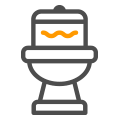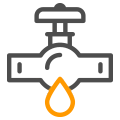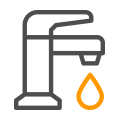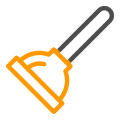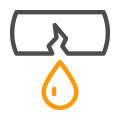Plumbing issues, especially clogs that prevent water from draining, are one of the most common problems seen in Sydney homes. Blockages in the drainpipes or other components of the plumbing system can be just as frustrating.
Pipes and drain blockages can be a real pain. They may be difficult to clean and result in several issues, such as a clogged sink. However, the good news is; you may be able to unclog a drainpipe by yourself with just a few inexpensive and easily accessible supplies.
Ways to unblock drainpipes
Make use of the plunger
A plunger can be used to unclog any drain in your home, including the bathtub, the toilet, and the sink. Plungers have a long, straight handle with a rubber cup-like mechanism at the end. The rubber part functions as a suction cup to pull debris out of the pipes and restore normal air and water movement.
There should be at least two to three inches of water in the sink or bathtub. With the help of the water, the obstruction in the drain should be removed as you use the plunger. To create extra pressure while plunging, seal off any surrounding drains with a rag or stopper.
Using the plunger, just position the cup over the drain and repeatedly pump the handle up and down. If the draining is still sluggish after several attempts, you may need to replace certain pipe sections. Once the blockage has been removed, you can flush it down the drain by turning on the water.
Use of the drain snake
If a plunger is unsuccessful in unclogging the drain, a drain snake should be used. You can free up a clogged drain with the use of a drain snake, which consists of a long, flexible piece of steel coupled to a handle. One of the most distinguishing features of a drain snake is its spiral-shaped auger at the very front. You may find them for sale at any hardware stores like Bunnings.
Put the auger end of the snake into the drain. Turning the drain snake as you put it in will help it move more smoothly through the pipe. After the drain snake has been placed, you can begin to gradually remove it. The procedure should be able to dislodge the debris that is creating the blockage. This process may need to be repeated multiple times before you can be sure that your pipes are clear.
Using a jet blaster for clogged pipes
In order to clear a clogged drain, high-pressure drain blasters direct a stream of pressurized air into the pipe. Put the end of the gadget on the drain that’s clogged, then pump it several times to unleash a blast of air.
Use chemical
Purchasing Liquid based cleaner
Liquid drain cleaning, available at most local shops, is a standard method for clearing out clogged drainpipes. Although these chemical solutions are usually quite effective, they may harm pipes that are particularly old or worn out.
You can usually use an entire bottle to clear out clogged pipes but follow the directions on the label just in case. If you’re planning on taking a shower or bath before letting the chemical solution set in, you should wash it all down with hot water first.
Using Powder based chemicals
Since powder-based cleansers are less corrosive to pipes than liquid ones, some people choose to use them. The majority of these powders have the drain-unclogging ingredient sodium hydroxide. Due to its rapid efficacy, the product does not have to be left in the drain to act for extended periods.
The powder in these goods dissolves in hot water, therefore it’s best to run hot water through the pipes for 1-2 minutes before dumping them in. To unclog a standard-sized drain, pour in around 2 cups of powder, let it sit for 2 minutes, and then flush with hot water.
Using DYI mixture for unclogging water pipes
An excellent and eco-friendly way to unclog pipes is by mixing vinegar, baking soda, and water. When combined with hot water, baking soda can break up any clogs in your drain, and the vinegar’s acidity will trigger a chemical reaction that will send the sludge on its way.
Cleaning of the drainpipes
Although it is the most laborious process, the success rate for clearing the clogged pipes is higher compared to the other above-mentioned methods. To clean the pipe thoroughly, the S-trap must be removed.
The first step is to put a container beneath the S-trap to catch the water that might leak out. Following this, use a wrench to take off the U-retaining bend’s caps, and then take off the S-trap itself.
Remove the obstruction, and then carefully reconnect the U-bend. If the drain is still clogged after doing this, the problem may be further up the pipe. It sounds like you need a plumber’s help if that’s the case.
Hire an expert if the condition is severe
If the solutions have failed to clear your drain, it’s time to take the help of a professional plumber. If you are living in Sydney, you can simply get in touch with a plumbing service provider like ourselves. Call for professional help, Dial Up (02) 8999 6125.
Conclusion
Pipeline & drainage systems require maintenance so that they can continue to function properly. As a result, it is vital to regularly clean your drainage system as frequently as possible to prevent clogged pipes.


